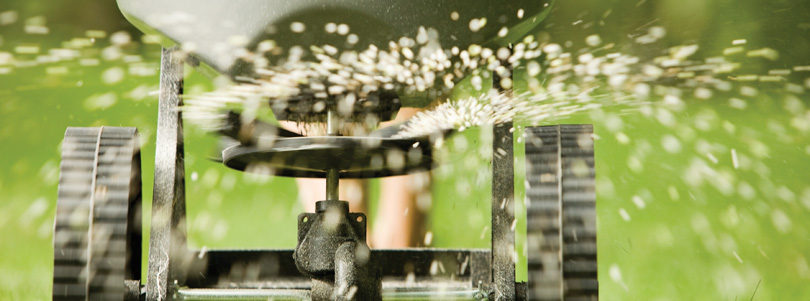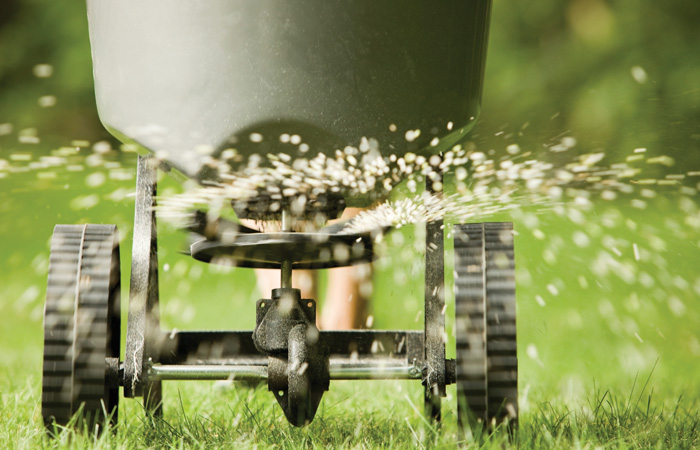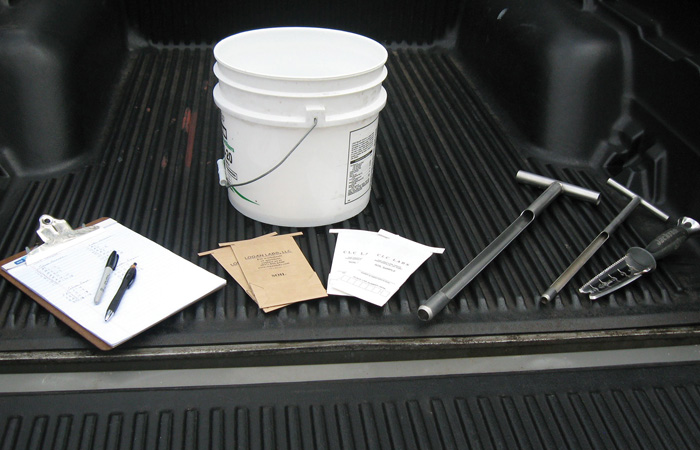Ask the Superintendent – Fertilizing Your Lawn

One of the best things about being a golf course superintendent is being surrounded by acres of healthy emerald green turf grass, from the club lawns to the putting greens there is no doubt about the beauty and serenity that high quality turf brings. Our footprint at Four Seasons Golf and Sports Club Dallas at Las Colinas features 289 acres of high quality turf. That’s a lot of green and responsibility. Guests and members alike often ask the most heart-felt questions. The one I hear most is, “Wow the course looks great, I want my lawn to be that healthy, what’s the best fertilizer for my lawn”? If you are one on the many avid golfers that aspire to have a great home lawn just keep reading and we will answer the question, what’s the best fertilizer for your lawn.

First, let’s identify the 16 essential plant nutrients and what they actually do for the plant.
Primary Nutrients
Used in large quantities by the plant
Nitrogen: forms proteins/amino acids, chlorophyll and cell formation, plant growth
Phosphorus: cell formation, protein synthesis and carbohydrate synthesis, root development
Potassium: water regulation and enzyme activity
Carbon: plant structures
Oxygen: Respiration and energy production
Hydrogen: pH regulation and water retention
Secondary Nutrients
Used in moderate quantities by the plant
Calcium: root permeability and enzyme activity
Magnesium: Chlorophyll production and metabolism
Sulfur: Protein and amino acids, vitamin and oil production
Micro Nutrients
Used in small quantities by the plant
Chlorine: Chlorophyll production and cellular development
Iron: Enzyme development
Zinc: Enzyme activity
Manganese: Enzyme activity and pigmentation
Boron: Enzyme activity
Copper: Enzyme activity
Molybdenum: Enzyme activity and Nitrogen fixation
I know what you are thinking, that’s a lot of science for a bag of fertilizer but stay with me and I promise it will get easier. There are a few things that you should know before we answer your lawn question. The 16 essential nutrients must be present and available to the plant in your soil for your turf to be truly healthy and occasionally you need to apply nutrients or fertilizer to make sure there are no nutrient deviancies. Most home owners will purchase a granular fertilizer in a 40 or 50 pound bag. So what’s the deal with the numbers on the fertilizer bag? The quick answer is that the three numbers on the bag are the percentages of nutrients present in the bag. The first number is Nitrogen (good for plant growth), the second number is phosphorus (good for root development) and the third number is Potassium (good for stress response (heat, traffic) so a 16–4–8 fertilizer has 16% Nitrogen, 4% Phosphorus and 8% Potassium. The label will also list (in small print) the sources the nutrients are derived from and any other nutrients and inert elements (filler) present in the bag. Remember the fertilizer label contains all of the pertinent information about the product and how to apply it safely.

Now to the matter at hand. What is the best fertilizer for your lawn? You will need a soil test to find out exactly what the best fertilizer is for your lawn. Sorry there is no magic elixir just good science. This is exactly how we handle fertility for the golf course. We don’t just apply fertilizer or amendments without a soil test because we want maximum results and value. Now for the insider tip, you can have a quick soil test done for just $12.00 by the Texas A&M Agrilife Extension Service, providing basic soil analysis and recommendations on the crop or lawn grass being grown. You can get all the information about soil testing including how to take a proper soil sample at their website www.soiltesting.tamu.edu so no excuses. The soil report will tell you the exact formulation of fertilizer to use and at what rate (pounds per 1,000 square feet of area) to apply to keep your lawn healthy. To speed up the process here is a quick guide on how to take a proper soil sample.
How to Take a Soil Sample
Tools Needed: Medium sized container, soil sample bag(s) these are available through Texas A&M Agrilife Extension Service (www.soiltesting.tamu.edu). Soil probe or hand spade, pen or black permeant marker, clip board and paper (to record dates and notes).
Step 1: Inspect the area (Lawn) make sure it is not too wet.
Step 2: Use a soil probe or spade to remove a 3” to 4” (average crop root depth) deep section of soil from 10 or more places equally spaced covering the entire area being sampled in a grid pattern. Remove any leaves, roots or debris and place only clean soil into your medium sized container.
Step 3: Mix all of the samples in the container together completely to make sure the samples are mixed as one new soil, make sure the aggregate mix is relatively dry.
Step 4: Fill out all of the address and crop information on the soil sample bag with a pen or black permeant marker and be sure to write legibly, take notes on turf conditions and shipping information to build a data history.
Step 5: Fill the soil sample bag to the designated fill line (do not overfill).
Step 6: Follow the shipping instructions on the bag.
Here are a few terms to be familiar with before you head to the garden center to pick up your recommended fertilizer. The term complete fertilizer means that each of the three primary nutrients (Nitrogen, Phosphorus, Potassium) are present in the bag and the term straight fertilizer means that only one nutrient is present usually in a high percentage such as a 0 – 0 – 50 Potassium fertilizer. You can also buy a micro fertilizer that has only secondary and micro nutrients present. Another general note of fertilizer is they are bought in dry or granular form, liquid or a powder that is to be mixed with water for spray or drench application such as Peters 20–20–20. I recommend that homeowners apply Granular fertilizer with a Rotary Spreader for lawns. You may find a recommended spreader setting on the fertilizer bag, but it is still a good idea to properly calibrate the spreader with each application. Here are the steps to calibrate a rotary spreader for a home lawn application.
How to Calibrate a Rotary Spreader
Determine the amount of fertilizer needed for 100 sq. ft. For example, the fertilizer bag weighs 50 lbs. and covers 10,000 square feet per the label recommendation
Place this amount in the spreader.
Mark off the area. For a rotary spreader, use a 10-foot by 10-foot area (100 sq. ft.).
Apply using the suggested label setting to the test site
Adjust the setting up or down based on the actual amount of fertilizer applied, if you covered the area completely with nothing left in the spreader you are perfect! If you have product left in the hopper increase the spreader setting, if you run out of product before the area is covered then decrease the setting. Repeat this process until you find the correct setting. Take notes for future reference
Complete the application for the rest of the lawn
Another professional tip for fertilizer applications is that instead of applying the amount of fertilizer needed (full rate) in one pass, apply a half rate of product in two perpendicular directions to minimize skips or severe overlaps. Walk at a consistent pace and watch for obstacles like trees and curbs. Apply fertilizer to dry turf and then water in according to the directions on the product label.
Now that you know the tools and the methods your lawn should shine like your favorite golf club entrance in no time. I hope that the grass will always be greener on your side of the fence and that yard of the month is in your future. We look forward to seeing you on the course soon. Once again I know what you are thinking, “now that I know how to get the best fertilizer for my lawn; how do I prevent weeds”? Well that is another question so stay tuned to Avidgolfer for more editions of ask the superintendent.
Anthony L. Williams, CGCS, CGM is the Director of Golf and Landscape Operations at the TPC Four Seasons Golf and Sports Club Dallas at Las Colinas, he is an award-winning environmental author with a degree in horticulture. Anthony can be reached at anthony.williams@fourseasons.com.



